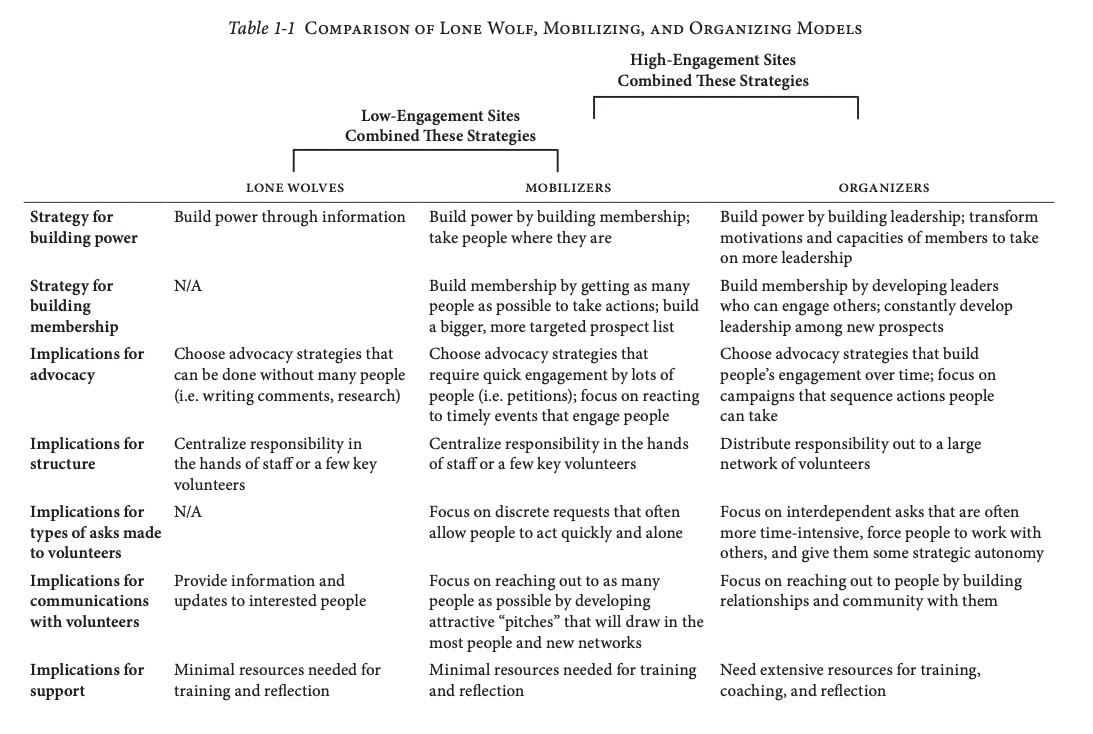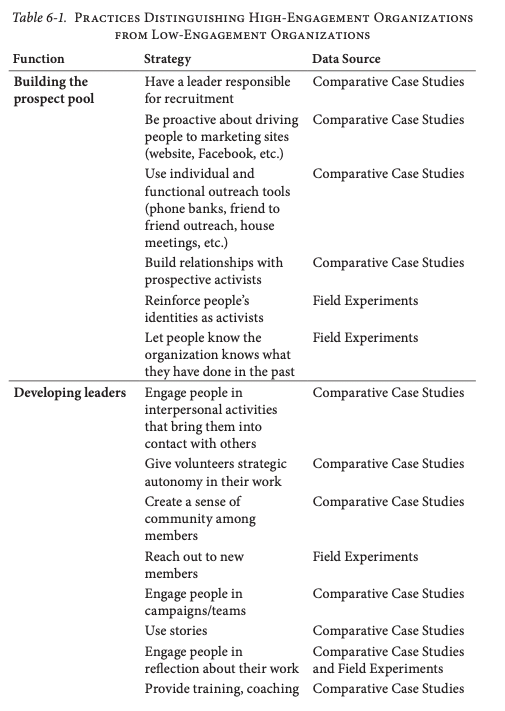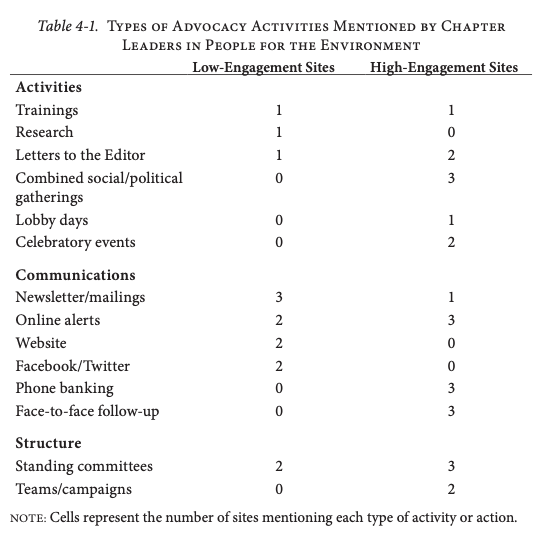This post is part of EA Strategy Fortnight. You can see other Strategy Fortnight posts here.
Book summary
I recently read an interesting book titled "How Organizations Develop Activists" by Hahrie Han.[1] She wrote the book to answer a simple question: why are some citizen groups better than others at ‘getting’ — and keeping — people involved?
To answer this question, she spent two years comparing organisations with strong records of engagement to those with weaker records.[2] She drew her case studies from two national associations that she refers to as ‘People for the Environment’ and the ‘National Association of Doctors’. People for the Environment tries to get citizens engaged around environmental issues, and the National Association of Doctors seeks to get doctors and medical students involved in advocating for health reform.
Her conclusion? You need a blend of ‘mobilizing’ and ‘organizing’.
Mobilizing is described as the act of getting people to participate in a specific event or action. It's about rallying individuals around a particular cause or event, often with a focus on quantity of involvement. Mobilizing efforts are typically centered around specific, often short-term, goals and are driven by the organization. These efforts might include activities like sending out email alerts, organizing lobby days, or hosting celebratory events.
Organizing, on the other hand, involves building ongoing relationships with people to foster a deeper, long-term commitment to activism. It's about investing in individuals and helping them develop as activists over time. The focus here is on the quality of involvement and the development of leadership skills among members. Organizing efforts are often more interpersonal and involve activities that build relationships and community, such as face-to-face interactions, personal recruitment, and creating a sense of community among members.
Han suggests that many organizations fall into a pattern of choosing mobilizing or organizing without having clear theories of change in mind. However, the book emphasizes that both approaches have their place and can be used effectively in different contexts. For instance, mobilizing might be more effective for short-term campaigns or events, while organizing might be more effective for building long-term capacity and fostering sustained engagement.
The book is filled with real-world examples and case studies, making it a valuable resource for anyone interested in understanding how to foster and sustain engagement within their EA community-building organisations.
I recommend this book to anyone interested in effective activism and community building.
My Main Takeaways
Blend Mobilizing and Organizing
Han emphasizes the importance of both mobilizing and organizing. Effective community building involves a balance of these two approaches. Mobilizing can help you reach a larger audience quickly, while organizing can help you cultivate a core group of dedicated activists. I think EA community builders have done too much of the latter. The Tien Procent Club shows the value of the former.
Keep Things Social
All three high-engagement entities in People for the Environment organized combined social and political gatherings, while none of the low-engagement entities do. Combined social-political events include happy hours, dinners, coffees, and bike rides that seek to accomplish an explicitly political goal, but do it in a way that combines socializing with advocacy work.
Develop Leaders
Han introduces the concept of an "activist ladder" with leaders at the top. Leaders are those who take responsibility for outcomes and commit to leadership development. As a community builder, you should aim to develop leaders within your community who can take on responsibilities and help others achieve their goals. We at EA Netherlands have really seen the value that comes from doing this after we helped a bunch of university students start new groups last year.
Further details
The above captures the main thrust of the book but in case you want to read more I've included extra info below.
How did the high-engagement groups differ from the low-engagement groups when it came to growing their organisations?
See the below table for info on the strategies and organizing principles used by the high-engagement organizations to build their prospect pool (that can be used to identify potential leaders) and then develop leaders. More details on each of these strategies/principles can be found in chapters 5 and 6 of the book.
How did the high-engagement groups differ from low-engagement groups when it came to working on their goals?
Han conducted interviews with chapter leaders and gathered data on what they did to accomplish their advocacy goals. Comparing the kinds of activities mentioned by People for the Environment leaders from low- and high-engagement groups provides insight into the ways organizers differ from mobilizers in how they think about engaging volunteers to build power for advocacy.
Table 4-1 summarizes the kinds of activities chapter leaders mentioned. The table is divided into three categories. “Activities” refers to general events and actions. “Communications” refers to activities that specifically have to do with communicating the chapter’s message. “Structure” refers to comments interviewees made about how they structure their advocacy work. It is important to note that the table is not a complete accounting of all the work these chapters do; it is an accounting of the things leaders mentioned when asked about their advocacy work.
Below is a selection of quotes from Han’s interpretation of this data. She draws attention to three key differences between low- and high-engagement chapters.
First difference
“The starkest difference emerges in mentions of combined social and political gatherings. All three high-engagement entities in People for the Environment organize such events, while none of the low-engagement entities do. Combined social-political events include happy hours, dinners, coffees, and bike rides that seek to accomplish an explicitly political goal, but do it in a way that combines socializing with advocacy work. Leaders at high-engagement entities were also more likely to mention lobby days, in which they organize groups of activists to go to the state capitol and lobby legislators, and celebratory events, in which activists working on a project get together to celebrate and debrief at particular benchmark points.”
“Low-engagement entities were more likely to accomplish their advocacy by focusing on activities that people can do alone. The low-engagement entities organize fewer activities overall, in part because they are unable to generate enough turnout to make social-political gatherings like a happy hour worthwhile. One low-engagement entity mentioned focusing on research. The strategy was to engage volunteers in conducting research on current policy issues and then generating research reports that could be shared with decision-makers. This research, notably, was generally done by one individual with expertise or interest in the area, who worked alone.”
“Leaders from low-engagement entities were also more likely to talk about their communications strategy as part of their advocacy work. By conflating communications and advocacy, these low-engagement groups revealed an advocacy philosophy that focused more on broadcasting information out than creating advocacy opportunities that brought people in. Even as they communicated information out, they did so in ways that lacked interpersonal contact. When asked how they engage activists in advocacy, leaders of low-engagement groups mentioned that activists could be asked to write for the newsletter, post things on Facebook or Twitter, or maintain the chapter’s website.”
“Leaders of high-engagement entities were less likely to mention communications as part of their advocacy work, but when they did, they were more likely to describe a communications strategy that brought people into close contact with each other. All of the chapters mentioned using on- line alerts to reach out to and activate their members. High-engagement entities also engaged activists in actively reaching out to other activists through phone banking and as much face-to-face follow-up as possible.
Two of the high-engagement entities mentioned having weekly or monthly phone-banking nights, when activists gather at a central location to call other activists in an effort to engage them in activity. The phone banks themselves are social activities. When I observed one of these events, activists spent the first 15 to 30 minutes socializing over snacks and drinks they had brought to share. Even after they began making phone calls, they would frequently take breaks to chat about conversations they had or things they were thinking about. When one activist finished all of his calls earlier than everyone else, he hung around to support his friends instead of leaving. In addition, the conversations themselves were often quite chatty. While many of the calls they made resulted in leaving a message, when they did reach a person, activists were likely to take a few minutes to chat with the person instead of simply running through a routinized phone script. The activity itself and the way these entities engaged in the activity fostered interpersonal contact, autonomy, and fun.”
Second difference
“A second difference that emerged in the way leaders from high- and low-engagement chapters described their work is the extent to which they gave volunteers strategic autonomy to complete the work. Leaders in high-engagement entities reported asking activists not only to attend events but also to help plan them. Planning includes everything from being part of the event committee, to managing logistics for the event, to recruiting others to attend. In engaging activists to plan and attend these events, high-engagement entities gave activists ownership over the work….
Recognizing the importance of giving volunteers ownership over an activity, high-engagement entities give activists decision-making authority over how events are designed and planned. This autonomy affords them greater investment in making the events successful. In contrast, activists in low-engagement entities often have little autonomy in the work they do. Penny says, ‘An awful lot of what’s going on as far as [advocacy] right now is being spear-headed by our staff person. She gives things to activists and tells them what to do so that it’s easy for them.’ Instead of giving activists autonomy in their work, the staff members simplify the work for activists by spelling out directions in as much detail as possible.”
Third difference
“A third difference emerged in the way chapters structured advocacy work. Both high- and low-engagement entities mentioned using standing committees. These committees seemed to be of widely varying utility for all of the chapters. They were often issue-based committees whose agendas were relatively undefined and whose work varied based on the energy that people on the committee put into it. Activists could languish on the committee for months or years without any real focus. Two of the high-engagement chapters, however, also mentioned organizing their activists into campaigns or teams that had a defined goal, a clear focus, and were proactive about accomplishing those goals….
Campaign-based teams focused on projects that had a definite beginning and end, and a clear direction for the work activists were doing. Activists who were part of campaign teams, in contrast to those on standing committees, had a clear set of goals they were trying to accomplish, and strategies they were using to reach those goals. Campaign teams were better at providing a sense of meaning about the work because activists had a better sense of the big picture and the ways in which the work they were doing fit into it.”
- ^
It was recommended on the How I Learned to Love Shrimp podcast, thanks guys!
- ^
The first phase of her research consisted of two-year comparative case studies. In these case studies, she identified matched pairs of civic associations that were working on similar issues in similar communities and recruiting similar kinds of people — but differed in the levels of engagement they inspired. She drew all of her matched pairs from two national associations that she refers to as ‘People for the Environment’ and the ‘National Association of Doctors’. People for the Environment tries to get citizens engaged around environmental issues, and the National Association of Doctors seeks to get doctors and medical students involved in advocating for health reform. Each matched pair consisted of local chapters working within the same national association. In total, she observed six pairs of local chapters in two national associations (twelve chapters total, six in each association).
The second phase of the project, the field experiments, built on hypotheses generated in the first phase to test their effectiveness in the context of online mobilization. These experiments examined how organizational actions affected the individual choice to take action.



